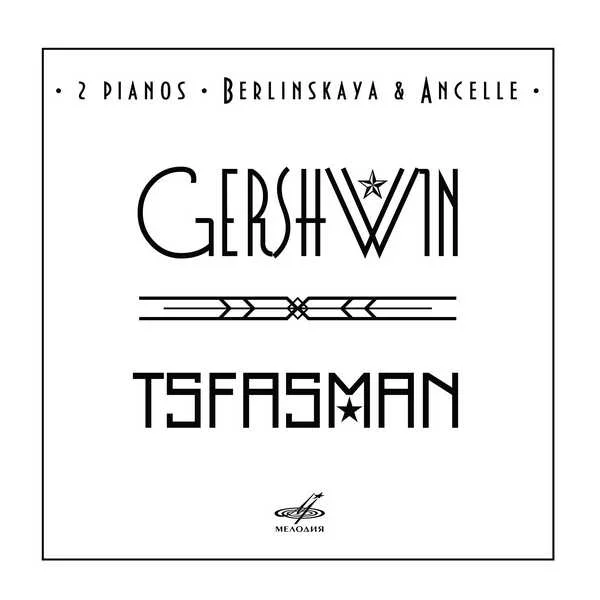
Composer: Alexander Tsfasman, George Gershwin
Performer: Ludmila Berlinskaya, Arthur Ancelle
Format: FLAC (tracks)
Label: Melodiya
Catalogue: MEL CD 1002564
Release: 2022
Size: 207 MB
Recovery: +3%
Scan: yes
01. Stone: Paraphrase on Gershwin’s “The Man I love”
Tsfasman: Jazz Suite (Arr. Igor Tsygankov for 2 Pianos)
02. No. 1, Snowflakes
03. No. 2, Lyric Waltz
04. No. 3, Polka
05. No. 4, Fast Movements
Gershwin: 4 Songs (Arr. Paul Posnak for 2 Pianos)
06. ’S Wonderful / Funny Face (From Musical “Funny Face”)
07. But Not for Me (From Musical “Girl Crazy”)
08. Someone to Watch Over Me (From Musical “Oh, Kay!”)
09. Sportin’ Life’s Song “It Ain’t Necessarily So” (From Opera “Porgy and Bess”)
Tsfasman: 4 Songs (Arr. Arthur Ancelle for 2 Pianos)
10. No. 1, Expectation
11. No. 2, Jolly Night
12. No. 3, Dancing Fingers
13. No. 4, Always With You
Gershwin: 3 Preludes (Arr. Gregory Stone for 2 Pianos)
14. I. Allegro ben ritmato e deciso
15. II. Andante con moto e poco rubato
16. III. Allegro ben ritmato e deciso
17. Gershwin: Variations on “I Got Rhythm” (Arr. for 2 Pianos)
18. Gershwin: Fantasy on Gershwin’s “The Man I love” (Arr. Igor Tsygankov for 2 Pianos)
Gershwin – Tsfasman – Gershwin: Jazz vs Classiques?
The new project of the Russian-French piano duet of Ludmila Berlinskaya and Arthur Ancelle, who have already released a series of albums on Melodiya, is dedicated to the luminaries of Soviet and American jazz. Popular songs by George Gershwin and Alexander Tsfasman arranged for two pianos alternate with the two composers’ original compositions.
“For us, this album is a real challenge: to succeed in creating a unique style, a mixture of jazz with classical music. We must preserve the pianism and virtuosity, the subtlety of writing, distribute the colors, the precision of the ensemble, as we do when we deal with the classical repertoire, and at the same time find the relaxedness, the swing, which is so unnatural for the classical pianists that we are…”
Ludmila Berlinskaya and Arthur Ancelle
The choice of the program – a combination of two unequal (at first glance) names – may seem surprising to someone. “Gershwin was known everywhere… Gershwin did not even know about his [Tsfasman’s] existence”, the performers write in the liner notes to the album. But were they really so far from each other?
“Gershwin seems to have accomplished this miracle … He is the Prince who has taken Cinderella by the hand and openly proclaimed her a princess”, the American conductor Walter Damrosсh wrote about the “miracle” of the synthesis of jazz and classical-romantic traditions in the American composer’s works (his ancestors were born in Russia, incidentally). As for Tsfasman, who was taught by Felix Blumenfeld at the Moscow Conservatory, his virtuosic playing admired the elders of Russian piano art. And he accomplished his own miracle as well – his AMA-Jazz orchestra made the first jazz record in the USSR and was the first to perform jazz on the All-Union Radio (and later on television) and recorded music for the first Soviet sound film. Many of Gershwin’s melodies were hits during his lifetime, but millions of people in this huge country hummed Tsfasman’s tangos, songs and foxtrots in the 1930s.
When we hear Gershwin’s songs and preludes, Rhapsody in Blue, and Porgy and Bess, the question whether this music is “serious” or “light” drops. The program of the album is conceived in a way that at some point we stop noticing where Gershwin “ends” and where Tsfasman “begins”. It doesn’t really matter anymore. We just surrender to the spontaneous rhythm, to the call of the sensual melodies, to the freedom of the relaxed musical flow. And the logical ending of the album is Tsfasman’s Fantasy on the Gershwin’s immortal The Man I Love, where the composer and the interpreter merge into one whole.



